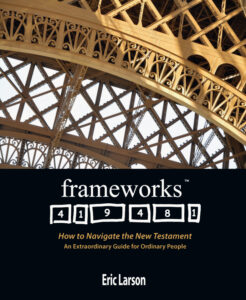4 Reasons This Book Will Make You a Better Reader and Teacher of the New Testament
 I’ve had the privilege of teaching a number of new Christians over the past few years. I remember sitting with one teenager and realizing that he didn’t know the big numbers in his Bible were chapters and the little numbers were verses (he had never read a Bible before). When I teach now, I remind myself to be conscious of where my listeners are starting from. Frameworks offers some great long-lasting concepts which are approachable for first-time students of the New Testament. I love it as a teacher and I recommend it for new Bible readers as well.
I’ve had the privilege of teaching a number of new Christians over the past few years. I remember sitting with one teenager and realizing that he didn’t know the big numbers in his Bible were chapters and the little numbers were verses (he had never read a Bible before). When I teach now, I remind myself to be conscious of where my listeners are starting from. Frameworks offers some great long-lasting concepts which are approachable for first-time students of the New Testament. I love it as a teacher and I recommend it for new Bible readers as well.
Frameworks describes itself as “An Extraordinary Guide for Ordinary People”, and it lives up to that high expectation. This is not a New Testament guide written for students in the academic world. This guide is written for people living in the real world. The moment I thumbed through the pages I was caught by the simple layouts and high impact images. Eric Larson’s “less is more” approach goes beyond the look. The text of Frameworks follows this philosophy as well.
Here are four reasons this book will make you a better reader and teacher of the New Testament:
- Simplicity That’s Helpful
There’s no clutter here. Larson keeps it simple, which is hard to do. There’s plenty of information which could be packed into an overview of each book of the Bible, but Larson practices restraint by focusing on those themes which are central and most helpful for each book. Some may quibble about specific dates and alternate outlines, but Larson goes with widely accepted theories and presents one way to put the pieces together. This is a great approach for teaching beginning Bible readers. - Handles You Can Hang On To
With each book of the New Testament, Larson includes one or two images or stories to serve as metaphors for the major themes of the book. His visuals are excellent, and I’ve already begun making use of them in my own teaching. They’re great images because they work. They help make sense of each New Testament book, and they do it in a way that sticks with you. - Theology Everyone Can Appreciate
The author doesn’t present his denominational or theological background. It’s not necessary information for the content of this book. What comes across strongly is his belief that the Bible is the inerrant Word of God, given to make known salvation through Jesus. If this were a Lutheran resource I would be disappointed in a lacking perspective on sacraments and mention of law and gospel themes. Since the author is not Lutheran, I appreciate the more general nature of his content because it allows me to recommend his work without amending the content. - Visuals Which Draw You In
Larson does a great job of writing for an increasingly visual culture. Pictures capture our attention, and our thoughts, ideas and emotions are shaped daily by the images we meet. In our contemporary context, visuals are consistently integrated in our communication. Frameworks speaks the language of our culture. Each page is both attractive and informative.
The caution I will give is this: Don’t mistake Frameworks for a “one-size-fits-all” resource for all things biblical. Frameworks is filled with some great teaching tools and on-point analogies, but there are biblical topics – and important ones, like sacraments – which go untouched. In addition, while Frameworks may serve as a devotional aide (something to read alongside Scripture) it is not devotional material. The Word of God is explained in Frameworks, but it is never proclaimed to the reader. If anything, some wording in Larson’s explanation leaves room for individuals taking an active role in establishing a relationship with Christ. He’s careful to make Jesus the initiator, but uses wording that leaves room for human cooperation. At the same time, I almost hesitate to mention this negative because there are so many positives I see in this book (but, salvation’s a big deal so it’s worth mentioning).
If reading the New Testament is new for you, Frameworks will be a great aid. Maybe you’ve heard lots of Bible stories or various readings in church, but you’re not familiar with the context of some of those readings. Frameworks will help broaden your understanding.
If you’re in a teaching role, pick up a copy of Frameworks and allow it to inform your teaching. Let the simplicity of this guide remind you how overwhelming the Bible can be for new readers. Take some of the images and metaphors and make them your own as you teach. This book will be an asset to you and your students.






0 Comments